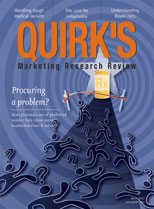Editor's note: Kay Corry Aubrey is founder of Usability Resources Inc., Bedford, Mass.
Usability testing is a vital part of the process of developing and introducing a new product or service. After all, you can create the greatest widget in the world but if no one can figure out how to use it, or if using it leads to anger and frustration rather than a sense of elation, you’ve not only wasted your organization’s precious time and resources, you’ve also alienated your customer base. While many marketers and researchers recognize the value of usability testing, I’ve found that there are a few knowledge gaps that require filling.
1. You need to watch what they do, NOT what they say!
The goal of a usability study is to put your product into the hands of a user and see what they do with it. Do they understand the nature of the product and its key features just by looking at it and touching it? Can they perform common tasks without a lot of frustration or cumbersome extra steps? What does their facial expression and body language communicate about how they feel as they use your product? Poorly-designed technology makes people feel dumb and cranky. Usability testing is unique from other forms of qualitative research because a participant’s behavior matters more than their words.
2. 10 (live) usability tests are plenty.
In our experience, 10 live tests expose 80 percent of a product’s usability issues (independent studies back this up as well). When a study is properly focused and the participants carefully chosen, you start to see repeating issues by the fourth or fifth session. By the ninth session things get very repetitive. On the positive side, this repetition clarifies where the problems lie. A benefit of running live tests is that you have the chance to talk with the participants so you can explore the dimensions of their confusion.
3. You should test early and often.
It’s important to find fundamental design flaws early because they are harder (and more costly) to fix later on. You don’t need to have a fully-functioning product before considering a usability study. If you can draw your idea on a piece of paper or represent it in foam core you can usability-test it. Quick prototypes give you the chance to explore basic aspects of the design such as the product concept or its navigation. When presented with a rough prototype vs. a polished interface, participants tend to offer more honest feedback because they can see not a lot of work was put into the presentation. Getting critical feedback early positions your product design in the right direction and saves you time, effort and money.
4. There are many good reasons for running usability studies.
The most practical reason is to catch usability issues before your customers do or to ensure users can interact with your product fluidly and intuitively. Other good reasons include having the opportunity to see real people using your product before it ships, to compare design approaches or to match your product against the competition. Whatever your reasons, usability testing shines a light on how well your product “speaks” to users, meets their expectations and fits into their typical work and task flow.
5. Make sure you are asking the right people for feedback.
When you are going to base important (and costly) strategic decisions on usability testing results you want to make sure you’re getting your feedback from people who match your target audience. You want it to be deep, unbiased and accurate. While enlisting family, friends and employees as participants for feedback saves money and is better than doing no testing at all, there are disadvantages. They may not be typical users, they may “know too much” or feel uncomfortable telling you what they really think because they don’t want to hurt your feelings. When the stakes are high, it makes sense to invest money to recruit participants who are objective and who represent your target user.
6. Testing icons vs. testing your product’s navigation requires a different mind-set.
There are distinct aspects to a product design and each requires a unique usability testing approach. At a foundational level you want to know if the product’s features, functions and content are appropriate for the intended audience. Does the product seem familiar to your audience? Does its organization and navigation align with the target user’s task and work flow and their understanding of how it should work? Do users know where to start, what to do next and the range of available choices? Do they understand the product’s terminology? And we haven’t even talked about whether they like its color scheme and button placement! A well-designed usability study will give insight into how you can improve distinct aspects of your product design.
7. Getting a functioning product out the door on time matters more than usability.
If you need to make a hard choice, it’s more practical to take your best guess at a proper design and focus on getting the technology to work. You can use the early versions of your product as an opportunity to gain an accurate understanding of who your users are and how well your product fits into their world. Then you can make refinements with each new version of the design. The process is iterative – with a commitment to usability you will get there!
